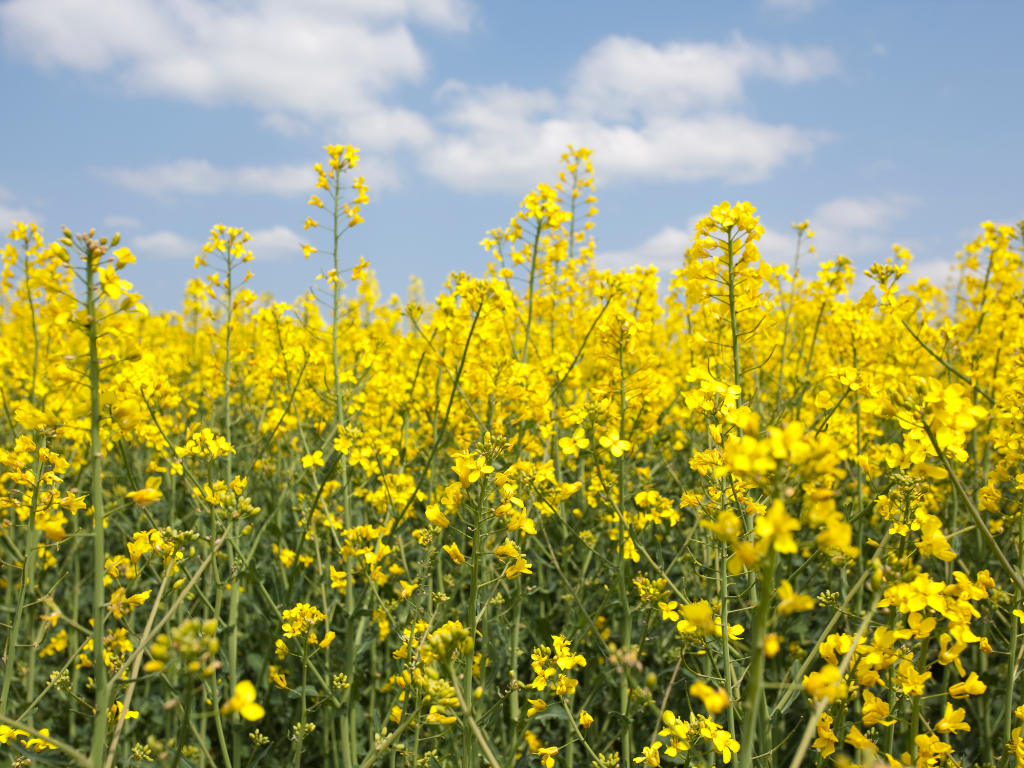History, Uses, and Nutritional value of oilseed rape (Canola)

This post is also available in:
This post is also available in:
![]() Ελληνικά (Greek)
Ελληνικά (Greek) ![]() Português (Portuguese (Brazil))
Português (Portuguese (Brazil))
What is the difference between canola and rapeseed oil?
The confusion between canola and rapeseed or industrial rapeseed is quite common. Both are annual oil crops of great economic importance. They belong to the Brassicaceae family and the Brassica napus species and are related to mustard, broccoli, cabbage, cauliflower, and turnip. The plants and the seeds of canola and rapeseed are almost identical and cannot be distinguished by eye.
The main and most important difference between canola and rapeseed is the seed content in erucic acid and the level of glucosinolates, substances toxic to animals and humans. Rapeseeds have a 45% of erucic acid and a high level of glucosinolates. The oil produced from industrial rapeseed is used as biofuel, plastics, and biological lubricants with resistance to high temperatures. On the contrary, canola has been bred to have less than 2% of erucic acid (double low cultivars or edible oil crops) and low levels (less than 30 μmol/g in meal fraction) of glucosinolates, making its oil perfectly safe for human consumption and its meal as an animal feed of good quality and high protein content (1).
This cultivation guide (the articles included in this category) will focus on canola (the edible rapeseed). However, many of the production techniques are similar to the industrial rapeseed.
The History of Canola
Rapeseed arose from the natural hybridization between turnip rape (B. rapa) and cabbage (B. oleraceae) that happened almost 7,500 years ago and became a crop of interest soon after, cultivated in many parts of the world. The name canola or “double low” variety was registered by the Western Canadian Oilseed Crushers in 1978. Today, canola is considered a highly profitable crop cultivated in over 66 countries globally, with Canada being the biggest rapeseed producer with 19 million tons (in 2019), followed by China, India, France, and Ukraine (2). The commercial varieties of canola available to the market belong into 2 types: the Argentine type and the Polish type. Their difference is that the cultivars of the first type have been developed from the species Brassica napus and the other from the Brassica campestris (3).
Which are the uses of canola?
Canola can be used:
- For Oil Production
- For human consumption
Canola’s seeds contain 35-45% oil, with the cropping being the second most produced oil crop globally after soybean (18% oil content) (4, 5). Furthermore, the seeds of the modern commercial varieties have a high level of polyunsaturated fatty acids (oleic, linoleic, and linolenic) and vitamins (E and K). As a result, the oil produced is considered quite healthy, and thanks to its mild flavor and resistance to heating, it is the most used vegetable-based oil for culinary reasons (frying, salads and dressing, cooking, baking).
- As forage
Another potential for canola is to be exploited as an annual forage. Due to its high protein content (23-33%), it can substitute soybean meal in animal (cattle and poultry) rations (10-20% in feed mixes) (6). Furthermore, it can be used for grazing directly and can produce up to 1-2 tons of dry matter per acre annually.
- As a cover crop in a crop rotation plan
It is preferred due to the deep taproot system that can help reverse (up to a level) the soil compaction. Canola is usually sown before or after winter and spring cereals, like wheat and corn, and is succeeded by a double-cropped soybean (7). More specifically, the rotation benefits of canola to wheat yield (up to 19% higher) and quality has been recognized both by scientists and farmers. It also helps in the management of important cereal weeds and soil-borne pathogens (like take-all (Gaeumannomyces graminis) (8). Finally, since it is usually the first crop, after almond trees that flower in spring, it is an important food source for pollinators (like honeybees).
Health Benefits of Canola Oil
Canola is considered one of the top oil crops globally due to the good quality and nutritional value of the vegetable oil extracted by its seeds. Except for the oil’s neutral taste, light color, and good stability and resistance to heat, the food industry and consumers prefer it over others also due to the important health benefits that it offers.
The canola oil stands out due to its fatty acid profile. With zero trans-fat, a high level of oleic acid, omega–3, and omega–6, high content of tocopherols and phytosterols, and the lowest amount of saturated fat among the common cooking oils, canola oil is considered one of the healthier cooking oils available. Additionally, among other things, it can lower cholesterol (up to 10-15%) and improve heart health. Additionally, the antioxidants and vitamins (E and K) of the oil can reduce the risk of cancer, combat free radicals, and prevent damage to the brain while improving skin health and hair (9, 10).
Nutritional value of canola oil
One tablespoon (15 ml) of canola oil has:
- Calories: 124
- Total fat: 14 g
- Saturated fat: 1 g
- Monounsaturated fat: 9 g
- Polyunsaturated fat: 4 g
- Linoleic Fatty Acid (Omega-6): 2.25 g
- Alpha-Linolenic Fatty Acid (Omega-3): 0.9 g
- Vitamin E: 16% of the Daily Value (DV)
- Vitamin K: 8-12% of the DV
References
- https://www.canolacouncil.org/about-canola/
- http://www.fao.org/faostat/en/#search/Rapeseed%20
- https://hort.purdue.edu/newcrop/afcm/canola.html
- https://www.statista.com/statistics/267271/worldwide-oilseed-production-since-2008
- https://www.agmrc.org/commodities-products/grains-oilseeds/rapeseed#:~:text=Rapeseed%2C%20(Brassica%20napus%20var.,yellow%20flowers%20with%20four%20petals.
- https://extension.missouri.edu/publications/g4162
- https://extension.psu.edu/canola-or-rapeseed-production-in-pennsylvania
- http://www.regional.org.au/au/gcirc/canola/p-06.htm#P635_63574
- https://www.mdpi.com/2073-4395/11/9/1776/htm#B3-agronomy-11-01776
- https://www.canolainfo.org/health/fat-chart-and-nutritional-analysis.php









































































